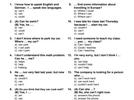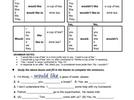Compartida por: Silvia Raya
0 votos
| 18123 | Planeación Interactiva de educación básica | ||||||||||
| Nivel escolar | Primaria | Grado escolar | 4to grado | Campo y Asignatura | Inglés | Bloque | II | Semana | 18 | Sesión | 1 |
| Ambientes sociales de aprendizaje | Familiar y comunitario | ||||||||||
| Actividad Comunicativa | Intercambios asociados al entorno | Duración | 0 horas, 50 minutos | ||||||||
| Práctica Social del Lenguaje | Interpreta y usa expresiones para recibir y ofrecer ayuda. | ||||||||||
| Aprendizaje Esperado | Intercambia expresiones utilizadas para ofrecer y pedir ayuda. | ||||||||||
| Etapas | Tiempo sugerido | Secuencia didáctica | MED | Bibliografía | |||||||
| Inicio | 00:10 | 1. Download the file suggested in the “MaterialesEducativosDigitales” section and have the beam projector ready to wok with a video. 2. Review the concept of modals with students and make sure they identify the different uses of CAN and COULD particularly when asking for and offering help. 3. Tell students they are going to practice with CAN and COULD. |
|
||||||||
| Desarrollo | 00:25 |
4. Distribute the worksheet and ask students to complete the sentences with the corresponding form. 5. Monitor the activity. 6. Check answers with the class by reading the sentence and having students to answer and identify if the context means “ability, permission, asking for or offering help”. 7. Invite students to produce some original sentences |

Can and Could: uses review
|
||||||||
| Cierre | 00:15 | 8. discuss with students the uses of CAN and MAY and the levels of formality they both show when asking for permission. 9. Play the video and ask questions, “ Where are they going? Why did the girl want to call her friend from the bus? How does she ask if can do it? What does the boy ask when he gets hungry? 10. Discuss students' answers and ask them to think of other possible questions with CAN or COULD the couple could ask in that situation,i.e., asking for help for example. 11. Write some of those questions on the board for students to copy in their notebooks. |

May vs. Can uses
|
||||||||
| Evalúa | A formal expresion you can use to offer help is, a) May I help you? b) I cannot help you? c) Can't you help me? d) I can help you. | ||||||||||
Compartida por: Silvia Raya
0 votos
| 18124 | Planeación Interactiva de educación básica | ||||||||||
| Nivel escolar | Primaria | Grado escolar | 4to grado | Campo y Asignatura | Inglés | Bloque | II | Semana | 18 | Sesión | 2 |
| Ambientes sociales de aprendizaje | Familiar y comunitario | ||||||||||
| Actividad Comunicativa | Intercambios asociados al entorno | Duración | 0 horas, 50 minutos | ||||||||
| Práctica Social del Lenguaje | Interpreta y usa expresiones para recibir y ofrecer ayuda. | ||||||||||
| Aprendizaje Esperado | Intercambia expresiones utilizadas para ofrecer y pedir ayuda. | ||||||||||
| Etapas | Tiempo sugerido | Secuencia didáctica | MED | Bibliografía | |||||||
| Inicio | 00:10 | 1. Have the beam projector ready to show the video and download the worksheet suggested in the “MaterialesEducativosDigitales” section. 2. Review with students the different modals that can be used when asking for and offering help. |
|
||||||||
| Desarrollo | 00:25 |
3. Play the video and pause it right after the first situation has been presented (at the hotel) for students to answer these questions, “ Who is asking for help, and who is offering help? Can you identify the levels of formality in the dialog?” 4. Ask students to identify the expressions used to offer help. 5. The next part of the video shows the analysis of the expressions used and gives more examples. Decide how you want to present it, however, I is important that students write the expressions down and have a special section in their notebooks on this theme. 6. Play the third part of the video, a dialog between a couple, and ask questions, “What seems to be the problem? Who is helping who?”. 7. Finish the video by watching the description of the ‘informal language’ in this situation. You may want to give extra examples to students to feel comfortable with the structure. 8. Ask students to write a similar dialog in pairs and practice it with another pair. |

How to offer hel and request
|
||||||||
| Cierre | 00:15 | 9. Tell students they are going to review "Would like" in two different ways. 10. Distribute the worksheet and draw students’ attention towards the grammar tables. 11. Drive them to notice how ‘WOULD’ is used in affirmative and negative and what its meaning is. 12. Discuss with students the level of formality of this modal when asking for something. 13. Ask students to work in pairs and answer the exercise. 14. Check the answers with the class by asking different pairs of students to give their answers and identify if the sentence means ‘asking for’, ‘requesting’ or ‘offering’. |

Would like review
|
||||||||
| Evalúa | The question, "Would you like to order now?" is a polite form use in a ____. a) restaurant b) class c) school d) at home | ||||||||||
Regístrate y accede a todos los beneficios


